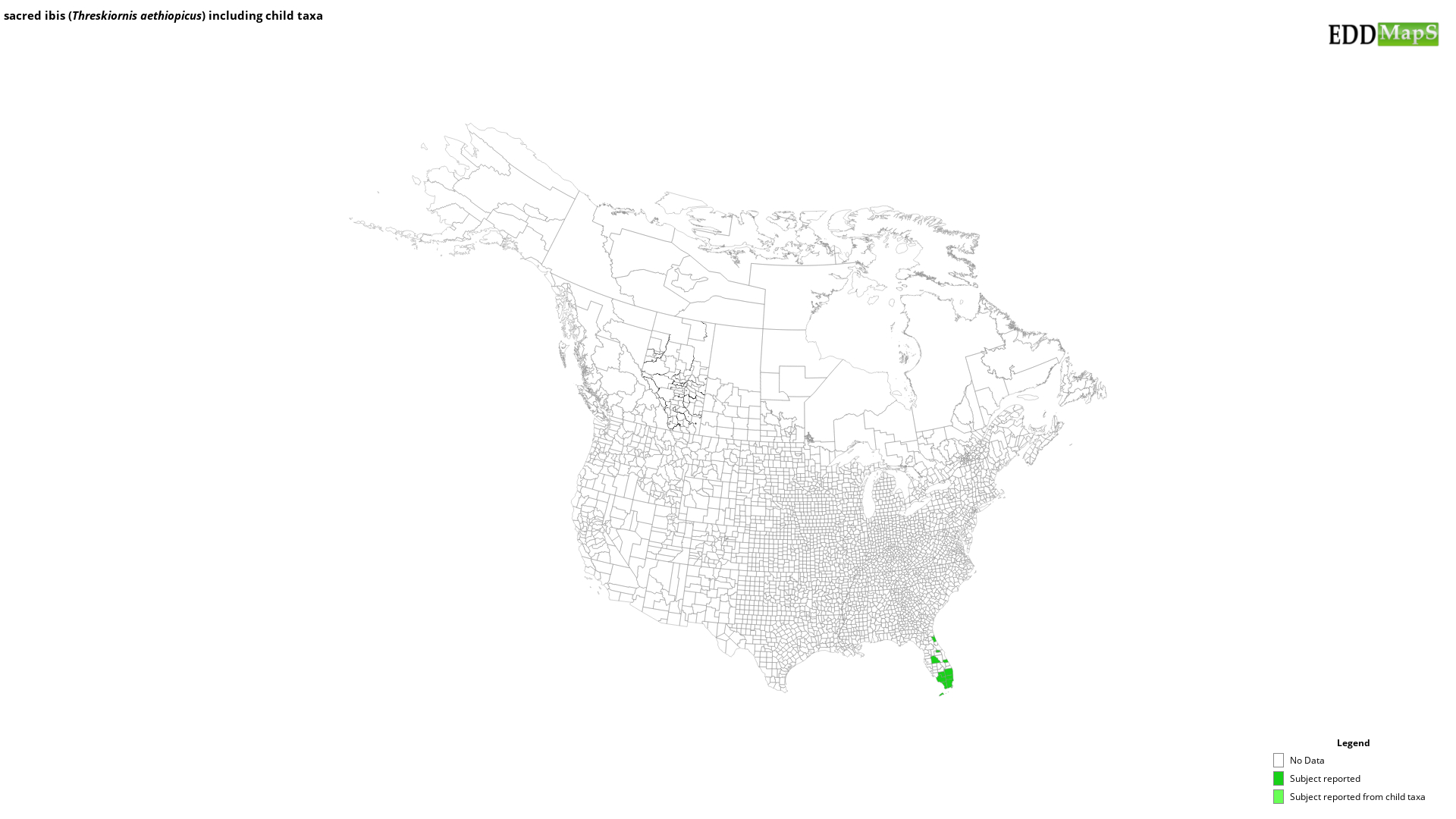sacred ibis
(Threskiornis aethiopicus)
This species is Introduced in the United States
Origin
Threskiornis aethiopicus is native to sub-Saharan Africa and the Middle East. Sacred ibis were introduced to the United States as escaped individuals from zoos or private collections.
Life Cycle
This species of ibis is larger than native species with a wingspan of 44-49 in. (75 cm) and approximately 30 in. (75 cm) in length. The plumage of adult T. aethiopicus is white in color on the body and wings and gray-black in color on the tips of wings. Adults are featherless on their heads and necks. Sacred ibis are generalists in their diet known to eat eggs and nestlings of birds, insects, crayfish, rodents, and other invertebrates and vertebrates. T. aethiopicus roost and forage in large groups. Breeding may occur individually or in large communal nests. Female sacred ibis lay 2-3 eggs that are incubated for 28-29 days. Young will remain in the colonies for an additional 44-48 days with both parents providing care.
Distribution
T. aethiopicus has only been found in southern Florida.
Control Efforts
Little is known about the impact of T. aethiopicus population in Florida.
https://ufdcimages.uflib.ufl.edu/IR/00/00/34/25/00001/UW31200.pdf
https://animaldiversity.org/accounts/Threskiornis_aethiopicus/
Threskiornis aethiopicus is native to sub-Saharan Africa and the Middle East. Sacred ibis were introduced to the United States as escaped individuals from zoos or private collections.
Life Cycle
This species of ibis is larger than native species with a wingspan of 44-49 in. (75 cm) and approximately 30 in. (75 cm) in length. The plumage of adult T. aethiopicus is white in color on the body and wings and gray-black in color on the tips of wings. Adults are featherless on their heads and necks. Sacred ibis are generalists in their diet known to eat eggs and nestlings of birds, insects, crayfish, rodents, and other invertebrates and vertebrates. T. aethiopicus roost and forage in large groups. Breeding may occur individually or in large communal nests. Female sacred ibis lay 2-3 eggs that are incubated for 28-29 days. Young will remain in the colonies for an additional 44-48 days with both parents providing care.
Distribution
T. aethiopicus has only been found in southern Florida.
Control Efforts
Little is known about the impact of T. aethiopicus population in Florida.
https://ufdcimages.uflib.ufl.edu/IR/00/00/34/25/00001/UW31200.pdf
https://animaldiversity.org/accounts/Threskiornis_aethiopicus/
Resources
- Wikipedia - Wikimedia Foundation, Inc
- Animals: Explore Discover Connect - Chaffee Zoological Gardens of Fresno.
- Florida's Introduced Birds - University of Florida
Selected Images
Maps
EDDMapS Distribution - This map is incomplete and is based only on current site and county level reports made by experts, herbaria, and literature. For more information, visit www.eddmaps.org
State Lists - This map identifies those states that have this species on their invasive species list or law.
Invasive Listing Sources
Taxonomic Rank
| Domain: Eukarya |
| Kingdom: Animalia |
| Phylum: Chordata |
| Class: Aves |
| Order: Ciconiiformes |
| Family: Threskiornithidae |
| Genus: Threskiornis |
| Threskiornis aethiopicus |
References
Common Name Reference: Integrated Taxonomic Information System on-line database.
Scientific Name Reference: Integrated Taxonomic Information System on-line database.


